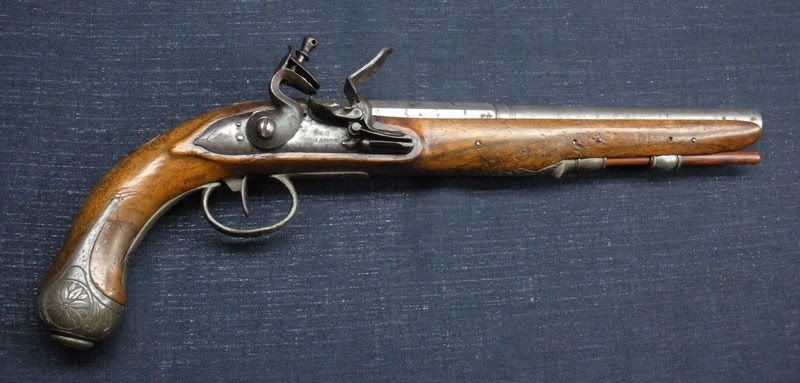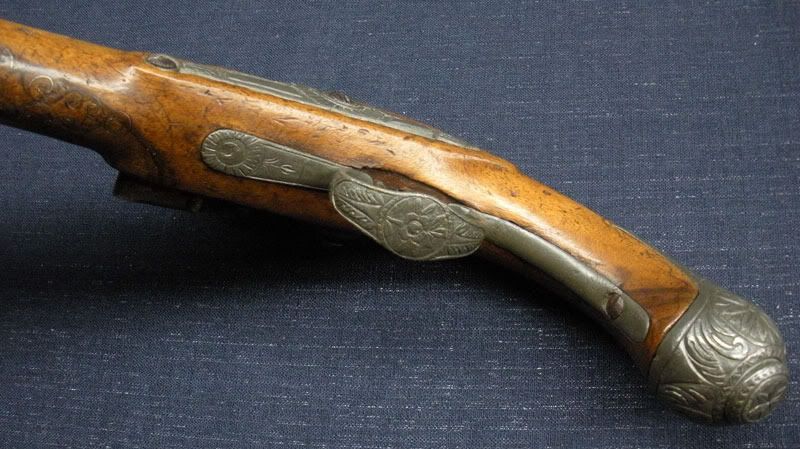
 |
|
|||||||
 |
|
|
Thread Tools | Search this Thread | Display Modes |
|
|
#1 |
|
Member
Join Date: Jul 2009
Posts: 607
|
The most interesting thing about this pistol for me are the pewter mounts, which I have never seen before. Caliber is ~16 mm. Barrel is 27 cm long, Liege-proofed, marked LONDON, and profusely-marked on the bottom and sides.
I show W. Chance and Son/Sons ca.1820s. The overall style of the decorations is to me suggestive of the Eastern, perhaps Persian vernacular. What are your opinions on this piece, and the barrel markings? Thank you.        
|
|
|

|
|
|
#2 |
|
Member
Join Date: Aug 2007
Location: CHRISTCHURCH NEW ZEALAND
Posts: 2,739
|
IMHO this pistol does not look English made to me. The quality of the engraving on the metal is not of the quality one would expect to see on an item of English manufacture, even the cheaper ones. Also the Belgian proof at least indicates that it was proved in Liege. Most English pistols were stocked in walnut, and this does not look like walnut.
IF it was imported into England then it SHOULD also bear British proof marks. Are there other marks you have not shown in the pics?---maybe under the barrel. I suspect that Chance is a retailer, rather than a maker. Regards Stuart |
|
|

|
|
|
#3 | |
|
Member
Join Date: Sep 2008
Location: PR, USA
Posts: 679
|
I must comment on the shape of the numbers, they look way too modern...
My two cents. Best M Quote:
|
|
|
|

|
|
|
#4 |
|
Member
Join Date: Jul 2009
Posts: 607
|
There are plenty of English-made pistols with more primitive decorations than are shown on this piece.
The proof of Liege, along with the absence of any British proof marks may indicate that the pistol was made for the Eastern trade. My main interest here is the mounts, cast either of lead, pewter, or a similar metal/alloy. As I wrote , I have never seen furniture like that. The floral decorations, including the roses, along with the crescent may point towards the Orient, I reckon. It is possible that the pistol was stocked in Turkey or Persia, from the European parts... The barrel and the lock are decorated en suite. |
|
|

|
|
|
#5 |
|
Member
Join Date: Jun 2008
Location: The Sharp end
Posts: 2,928
|
I have to say, its a nice looking pistol, but it is an unusual choice of material for the mounts!
The trigger guard especially. Pewter is so soft, scratches so easily and bends... well! Looking at the trigger guard and the thin metal aorund the screws, whatever this guns origins, its certainly a lucky survivor to still have a full set of these pewter mounts. Although... that aside! It can be polished to look like silver but is a lot cheaper, and it would look much more 'classy' than the more familiar bronze/brass mounts. So, I'd conclude that it had these mounts as a cheaper alternative to silver. OOh, just a thought, and you'd be brave to remove one.... They might have some kind of 'hallmark' I think, if they are English pewter. Didn't pewter made here often have 'pseudo' hallmarks? Last edited by Atlantia; 31st October 2009 at 10:39 PM. |
|
|

|
|
|
#6 |
|
Member
Join Date: Sep 2008
Location: PR, USA
Posts: 679
|
Guys,
What about my comments on the shape of the 9 and the 4? Are these usual for a putative 18th C dating? I undertand that flintlocks were used in some places up to the late 19th C, due to easier availabaility of blackpowder and flints, compared to industrial ammo. Could this be an export piece belonging to these places and later dates, or perhaps even made from earlier parts and retooled with new numbers? |
|
|

|
|
|
#7 | |
|
Member
Join Date: Jul 2009
Posts: 607
|
Quote:
Last edited by Dmitry; 1st November 2009 at 07:50 PM. |
|
|
|

|
|
|
#8 | |
|
Member
Join Date: Jul 2009
Posts: 607
|
Quote:
I definitely agree on the less expensive choice of mounting. When polished bright pewter resembles silver, which would be even softer, by the way. |
|
|
|

|
|
|
#9 | |
|
Member
Join Date: Jun 2008
Location: The Sharp end
Posts: 2,928
|
Quote:
It certainly looks like pewter in the pics, and the colour is right. As for the visible wear, it does look like its got the characteristic plethora of tiny marks that pewter often acquires over time. In general the whole gun looks like its been pretty well cared for. Its a rather nice piece! Are you tempted to take one off and see if there are makers/hall-marks on the back? |
|
|
|

|
|
|
#10 |
|
Member
Join Date: Jul 2009
Posts: 607
|
There were no markings on the inside of the counter plate.
|
|
|

|
|
|
#11 |
|
Member
Join Date: Dec 2004
Location: NC, U.S.A.
Posts: 2,097
|
Despite the sometimes brittle state of pewter, it was a valued alloy of the period. Early colonial American swords frequently used it in their hilts and grip strapwork. Likewise, along with brass and copper examples, there were even Native American trade tomahawk blades made from pewter. It does polish up quite nicely. In any case, I like this flintlock!
|
|
|

|
|
|
#12 | |
|
Member
Join Date: Jul 2009
Posts: 607
|
Quote:
I have never encountered an American colonial sword with pewter-mounted hilt. Would it be possible to indicate where I could see such swords? |
|
|
|

|
|
|
#13 |
|
Member
Join Date: Dec 2004
Location: NC, U.S.A.
Posts: 2,097
|
Yikes! I mis-spoke when I used the word "frequently". I have seen at least 1 colonial-made sword with pewter strapwork to it's hilt, but do not remember the site, nor have I been able to find it again-
 . (I will continue to search for the site, though...) I own a Rev War hanger with lead decorated hilt, likewise, lead was used in at least one example in Neumann's guide. As stated, pewter was used to make tomahawk blades of the period and shortly there-after (see Hartsler's and Knowle's book for numerous examples). Another part of a lead sword guard was found at a dig-site I saw online; again, I can't find the site again. . (I will continue to search for the site, though...) I own a Rev War hanger with lead decorated hilt, likewise, lead was used in at least one example in Neumann's guide. As stated, pewter was used to make tomahawk blades of the period and shortly there-after (see Hartsler's and Knowle's book for numerous examples). Another part of a lead sword guard was found at a dig-site I saw online; again, I can't find the site again.
|
|
|

|
|
|
#14 |
|
Member
Join Date: Dec 2004
Location: NC, U.S.A.
Posts: 2,097
|
[url]http://www.michaelsimens.com/items.asp?productCategory=Sold%Edged%20Weapons&pro ductCategory2=Sold%20Edged%20Weapons&productCatego ry3=Sold%20Edged%20Weapons
|
|
|

|
|
|
#15 |
|
Member
Join Date: Dec 2004
Location: NC, U.S.A.
Posts: 2,097
|
Oh well, didn't work.
 This site had a nice CW bowie in pewter mounts that had sold... This site had a nice CW bowie in pewter mounts that had sold...
|
|
|

|
|
|
#16 |
|
Member
Join Date: Jul 2009
Posts: 607
|
Lead was used to repair broken hilts, but to have lead used in the furniture of the new hilts..I've never seen one.
|
|
|

|
|
|
#17 |
|
Member
Join Date: Dec 2004
Location: NC, U.S.A.
Posts: 2,097
|
If possible, I'll try to find the site I spoke of. It was an archaeological dig-site with a well-preserved pommel and knuckle bow made of lead. Colonists being hard up for materials did use it mostly for repairs, but occasionally for function. I hate posting pics (!), not so good at it, but I'll try to show my rather primitive hanger with wood hilt, carved spiral grooves around it with lead strapwork/inlay decoration.
Last edited by M ELEY; 13th November 2009 at 05:46 AM. |
|
|

|
|
|
#18 |
|
Member
Join Date: Dec 2004
Location: NC, U.S.A.
Posts: 2,097
|
Not the one I saw, but here's a site with a partialy preserved hilt (it's a quarter of the way down page)
www.horsesoldier.com/catalog/c0024.html |
|
|

|
|
|
#19 |
|
Member
Join Date: Sep 2008
Location: PR, USA
Posts: 679
|
Found this:
http://www.sailorinsaddle.com/product.aspx?id=1005 "This fine W&G Chance of London holster-length pistol for the Persian market dates ca. mid-1800s. Liege-proofed barrel bears several maker and inspection marks. Barrel is 27 cm long, stepped from octagonal to round, with a wedding band transition. Caliber is ~16 mm. The stock is of exotic wood, sound, with no repairs or refinishing, and is profusely-inlaid with silver wire scrolled designs. Furniture is either pewter, or a similar alloy, finely cast in high relief and hand-chased with flowers, amongst them the Persian Rose - Gul, or Gulbahar, and the Crescent. Ramrod is an old replacement. Lock works very well, and the lock plate is decorated en suite with the barrel. All lock parts are original. " |
|
|

|
|
|
#20 |
|
Member
Join Date: Jul 2009
Posts: 607
|
Mark, the difficulty you're having with finding examples of American pewter and lead-mounted edged weapons is quite telling. There are very few examples extant, simply because this was not done. Granted, one may find an example or two, especially if you look at the old knives, but these usually date from the 1860s onward.
In fact, I would be skeptical and weary of pewter or lead-mounted swords offered as American Rev.War. period colonial pieces. |
|
|

|
|
|
#21 |
|
Member
Join Date: Dec 2004
Location: NC, U.S.A.
Posts: 2,097
|
Well, you are spot on with finding many examples. If this is the case, then I'm definitely going to post some pics of the short hanger I acquired not too long ago which I believed to be of the period. Perhaps it is post-Rev War or even Spanish colonial. I do not believe my item is any later than early 19th c, however.
Still, the flintlock in question is a beaut- |
|
|

|
|
|
#22 |
|
Member
Join Date: Jul 2009
Posts: 607
|
I'm very eager to look at the photos of your pewter-mounted side-arm.
Re:the pistol. To this day I don't remember where I read that pewter-mounted personal arms were in favor with the naval officers. I have since not encountered a single other reference supporting this, and came to think that it false. Brass was used, but even that is not a decisive characteristic in attributing one as a sea service piece. I definitely agree, it's a great looking gun on its own merit. I wonder what wood the stock is made of. |
|
|

|
 |
|
|